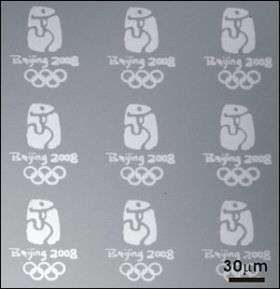Northwestern chemists take gold, mass-produce Beijing Olympic logo

Northwestern University nanoscientist Chad A. Mirkin has mass-produced the 2008 Summer Olympics logo -- 15,000 times. All the logos take up only one square centimeter of space.
Mirkin and his colleagues printed the logos as well as an integrated gold circuit using a new printing technique, called Polymer Pen Lithography (PPL), that can write on three different length scales using only one device.
The PPL technique, to be published Aug. 15 in Science Express, is a fast, inexpensive and simple way to print on the nanometer, micrometer and millimeter length scales.
The new printing method could find use in computational tools (the electronics that make up these tools), medical diagnostics (gene chips and arrays of biomolecules) and the pharmaceutical industry (arrays for screening drug candidates), among others.
"While watching the Olympics opening night ceremonies I was delighted to see that printing was highlighted as one of ancient China's four great inventions," said Mirkin, George B. Rathmann Professor of Chemistry in the Weinberg College of Arts and Sciences, professor of medicine and professor of materials science and engineering. Mirkin led the study.
"We consider Dip-Pen Nanolithography, which is nanotechnology's version of the quill pen, and now Polymer Pen Lithography to be two of Northwestern's most important inventions."
Polymer Pen Lithography uses arrays of tiny pens made of polymers to print over large areas with nanoscopic through macroscopic resolution. By simply changing contact pressure (and the amount the pens deform), as well as the time of delivery, dots of various diameters can be produced. (The pen tips snap back to their original shape when the pressure is removed.)
"We can go, in a sense, from an ultra fine point Sharpie® to one with a fat tip," said Mirkin, director of Northwestern's International Institute for Nanotechnology. "The tip of each polymer pen starts with nanometer-scale sharpness, but if we press down harder the tip flattens out. This gives us great flexibility in the structures we can produce."
In the case of the Olympic logo, the researchers started with a bitmap image of the logo and uniformly printed 15,000 replicas onto a gold substrate using an "ink" of the molecule 16-mercaptohexadecanoic acid. (The ink is a mere one molecule thick.) This took less than 40 minutes.
The logo is so small that 2,500 of them would fit on a single grain of rice. The letters and numbers, "Beijing 2008," were generated from approximately 20,000 dots that were 90 nanometers in diameter. Then, with more force applied to the pens, the stylized human figure and the Olympic rings were made from approximately 4,000 dots that were 600 nanometers in diameter.
The integrated circuit the researchers built had features on all three length scales, perfectly integrated together. Building the circuit took about two hours. As with the Olympic logo, the structures were made by making multiple printing passes with the same tool (the pen array, which has an ink reservoir).
Polymer Pen Lithography simplifies and takes the best of two existing printing techniques -- the high registration and sub-50-nanometer resolution of Dip-Pen Nanolithography (DPN) and the use of a polymer stamp to transfer a pattern in microcontact printing. (Mirkin invented DPN in 1999.)
The PPL method requires a dot matrix image of the structure to be printed (the Olympic logo, for example) and an atomic force microscope. The researchers have demonstrated arrays with as many as 11 million pens.
The Science paper is titled "Polymer Pen Lithography." In addition to Mirkin, other authors are Fengwei Huo (lead author), Zijian Zheng, Gengfeng Zheng, Louise R. Giam and Hua Zhang, all of Northwestern.
Source: Northwestern University




















